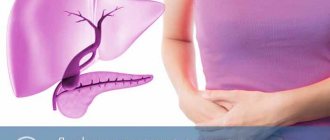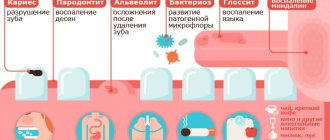The human body is very dependent on the supply of essential substances from the external environment with food. The work of organs and systems has a good reserve, is capable of providing increased load for a long time, but is interrupted if the energy balance is not maintained. And calories are formed only as a result of complex biochemical processes.
Humans obtain “reagents” for synthesis from food products. The best medicines cannot replace the natural process of nutrition through the stomach and deliver the substances necessary for life.
Diseases of the gastrointestinal tract are one of the first areas of therapy in ancient medical manuscripts, along with help for injuries. How to treat individual symptoms was taught even under Hippocrates and Avicenna.
Terms and classifications
The term “gastrointestinal tract” is very old, taken from anatomy. It implies and justifies its name - the stomach and intestines. More precisely, let's say - from the place of attachment of the esophagus to the anus. This means that only the pathology of these organs should be considered diseases of the gastrointestinal tract.
Modern knowledge about the digestive system has accumulated many facts about the inextricable connections between the work of the stomach, the causes of intestinal pathology and the functioning of other organs - the liver, gallbladder and ducts, and pancreas. Today's medical professionals more often use the term “diseases of the digestive system”; the old name refers to its expanded concept.
The International Statistical Classification has identified a separate class of diseases and calls it “Diseases of the digestive organs.” However, let us explain the features of statistical accounting. Gastrointestinal diseases in this group exclude the pathology that we are accustomed to attributing to digestive problems:
- diseases caused by infection (intestinal, parasitic, viral, including a large group of acute intestinal disorders, helminthiases, viral hepatitis) are classified as infectious;
- malignant and benign neoplasms of the stomach and intestines are included in a separate section of tumors;
- diseases of the veins and arteries such as ischemia, varicose veins, phlebitis, thrombosis (we are interested in portal vein thrombosis, pylephlebitis, hemorrhoids) are respectively considered in vascular pathology.
The list of diseases would be incomplete without congenital anomalies and defects (for example, achalasia of the esophagus)
Therefore, when territories report a stable state of gastrointestinal morbidity, they separately take into account the growth of viral hepatitis, outbreaks of intestinal infections, the danger of cancerous degeneration and identified new cases of neoplasms.
According to statistics published by the Ministry of Health, the number of gastrointestinal diseases has been trending downward in recent years. It firmly holds 4th–6th place in the total number after diseases of the respiratory system, genitourinary system, and skin (excluding injuries).
However, targeted studies and visits to medical institutions allow us to conclude that:
- up to 60% of the adult population suffer from digestive system disorders, and in large cities and metropolitan areas - up to 95%;
- among visits to therapists, gastrointestinal problems account for 37%;
- Men under 50 years of age suffer from peptic ulcers 3 times more often than women:
- ulcerative changes in the duodenum exceed those in the stomach by 8–10 times;
- the population remains insufficiently informed about the possibilities of early detection and timely diagnosis of malignant neoplasms of the stomach and intestines.
Data from attending physicians indicate that 4.5–5% of people in the Russian Federation die annually from diseases of the digestive system. In the structure of cancer mortality, colorectal cancer ranks second, and stomach cancer ranks third.
Doctors of various specialties treat diseases of the gastrointestinal tract: therapists, pediatricians, gastroenterologists, infectious disease specialists, oncologists, surgeons.
How to improve the functioning of the gastrointestinal tract
If abdominal discomfort is not the cause of a serious illness, and the symptoms indicate minor gastrointestinal disorders, then home treatment is possible. To do this, you need to give up cigarettes and frequent alcohol consumption, try to be less nervous and rest more, and eat right. To relieve pain in the gastrointestinal tract, antispasmodic tablets, for example, No-Shpa, Duspatalin or Neobutin, will help.
What to do if you have problems with the gastrointestinal tract
Restoring the functioning of the gastrointestinal tract is a long process of controlling your habits and self-discipline. The main thing is to adhere to the regime and a certain diet.
Basic nutrition rules:
- It is necessary to observe intervals between meals. You need to introduce breakfast, lunch and dinner into your daily routine, assigning them to a specific time. Snacks should be healthy and light. It could be fruit or yogurt, but not chips or a hamburger.
- The daily diet should include a first course. Hot soups and broths promote good digestion.
- Be more careful when choosing products. They must be fresh and natural.
- Drink more fluids, preferring clean drinking water.
What happens in the human digestive tract
The main functions of the digestive system are:
- motor-mechanical - allows you to crush, mix and move the food bolus along parts of the tract, remove toxins from the body;
- secretory - responsible for the chemical processing of food particles with the connection of various enzymes found in the juices of the organs concerned;
- absorptive - ensures the selection and assimilation from the contents of only the substances and liquids needed by the body.
In recent years, another importance of the digestive organs has been proven - participation in the synthesis of certain hormones and elements of the immune system. Diseases of the stomach and intestines are caused by a malfunction of one or more areas.
Of particular importance is the sufficient functioning of the duodenum, liver, and pancreas. According to their anatomical structure, these organs are very closely related to the gastrointestinal tract. Disruption of their work leads to dysfunction of the entire gastrointestinal tract.
Causes of digestive problems
Dyspepsia may have an organic cause - it is caused by gastrointestinal diseases, for example, gastroduodenitis, enteritis, intestinal polyps, stomach or intestinal cancer. But much more common is the so-called functional dyspepsia, the cause of which is not fully understood.
The following mechanisms of functional dyspepsia are postulated:
- motility disorders of the upper gastrointestinal tract - too slow gastric emptying, accumulation of gastrointestinal contents from the duodenum to the stomach;
- excessive secretion of hydrochloric acid and its too intense effect on the mucous membrane of the stomach and duodenum;
- abnormal reaction of the gastrointestinal mucosa to the composition, temperature, composition and structure of food.
The most important causes of gastrointestinal disorders
An important cause of diseases of the digestive system is poor nutrition. Main mistakes:
- long breaks in food intake - disrupt the reflex mechanism of the production of digestive juices, allowing significant concentrations of enzymes to accumulate in the stomach and intestines without food intake, which causes dangerous damage to one’s own mucous membrane;
- the predominance of fatty meat foods, fried and smoked foods, hot seasonings and sauces - contributes to the failure of the formation and flow of bile into the intestines, congestion in the bladder and increases the risk of stone formation;
- excessive consumption of alcoholic beverages - has a direct toxic effect on liver cells, the mucous membrane of the stomach and intestines, leads to increased consumption of enzymes, atrophic processes, promotes atherosclerotic damage to blood vessels and impaired nutrition of the walls;
- consuming foods of contrasting temperatures is an excessive irritant to the stomach; the habit of very hot drinks plays a role in the occurrence of gastritis.
What gastrointestinal diseases do people encounter most often?
Of the diseases caused by pathology of the stomach and intestines, the following pathologies should be noted as the most common diseases of inflammatory origin.
Gastritis
inflammation proceeds from a more favorable superficial one, to the formation of erosions and atrophy of the inner membrane, very different with high and low acidity, and dyspepsia is sure to occur.
Impaired motor function of the muscular layer of the stomach and sphincters
When the upper cardiac sphincter is weakened, the formation of gastroesophageal reflux disease with reverse reflux of acidic contents and damage to the esophagus is possible. If the contractility of the pyloric part changes, then pylorospasm or reflux of bile from the duodenum appears. This is how biliary reflux gastritis is formed.
Duodenitis
Duodenums, usually a complement and continuation of gastritis, somewhat change the nature of the symptoms. The pain becomes “late”, 1.5–2 hours after eating, and there is an admixture of bile in the vomit.
Gastroenteritis
The general name for diseases of the stomach and intestines, most often caused by infectious genesis, poisoning with low-quality products. They occur acutely with high fever, nausea and vomiting, pain of various localizations, and diarrhea. Children experience a dangerous symptom - dehydration.
Enterocolitis
Infectious and non-infectious lesions of the intestinal mucosa, possible manifestations of dysentery, typhoid fever, cholera. Patients are bothered by spastic pain in the left or right half of the abdomen, false urge to go to the toilet (tenesmus), and fever. The whole body suffers from intoxication.
Appendicitis
Local inflammation of the appendix has its own symptoms, but always requires differential diagnosis due to the anatomical features of the location.
Haemorrhoids
A disease of the rectal veins that affects the majority of the adult population. In origin, a tendency to constipation, sedentary work, and difficult childbirth in women are important. It manifests itself as severe pain in the anus, itching of the skin, and bleeding during bowel movements. Lack of treatment leads to the transfer of inflammation from dilated veins to nearby tissues, pinching of venous nodes, formation of cracks in the rectal mucosa, and cancer.
Dysbacteriosis
It is not considered an independent disease, but due to the nature of digestive disorders, the condition requires correction, additional therapy and special examination of stool for intestinal flora. It can be caused either by inflammation or by medications.
A decrease in the proportion of beneficial bifidobacteria and lactobacilli contributes to disruption of food digestion and activates opportunistic bacteria. Prolonged diarrhea is especially difficult for young children.
Peptic ulcer of the stomach and duodenum
Persistent painful symptoms, seasonality and damage to the mucous membrane up to the muscular layer, signs of bleeding are found in the stool. Severe complications are possible in the form of perforation of the ulcer into the abdominal cavity or neighboring organs. They manifest themselves as dagger pains and the patient’s state of shock.
Neoplasms of different localization
This includes polypous growths and cancer. Tumors form under the influence and against the background of various gastroenterological diseases. It is known that colorectal cancer is transformed from colon polyps, stomach cancer from atrophic gastritis.
Symptoms and treatment of gastritis of the antrum of the stomach
If the tumor grows inward, then manifestations are detected by a mechanical obstruction to the movement of feces (constipation). With external growth (exophytic), symptoms are not detected for a long time or have general intestinal manifestations (vague pain, unstable stool).
Quite rare gastrointestinal diseases include:
- Crohn's disease is a severe lesion of the entire digestive “tube” from the oral cavity to the rectum, in half of the cases - the ileum and rectum, and is classified as a hereditary autoimmune pathology in origin. The exact reason is unknown. Granulomatous growths grow throughout the entire thickness of the intestinal wall. The clinical manifestations are characterized by diarrhea, abdominal pain, and prolonged fever. It occurs as inflammation, spasm or perforation with the formation of fistula tracts.
- Whipple's disease - affects mainly men, is considered an infectious disease (the causative bacterium is isolated), but researchers emphasize the role of an excessive perverted reaction of the immune system. It manifests itself as prolonged diarrhea, fever and general symptoms (joint pain, damage to the skin, heart, eyes, hearing, neurological signs).
In a hiatal hernia, a protrusion into the chest cavity forms the esophagus and the upper edge of the stomach
Signs of stomach disease
Any deviation from the normal functioning of the body is accompanied by certain manifestations that cannot be ignored. You need to especially carefully monitor the state of digestion in a small child, who cannot yet talk about what sensations he experiences.
Disruption of the normal functioning of the digestive system has the following signs:
1. Lack of appetite. If the stomach does not give a signal that it is time to fill it, then there are serious reasons for this. As a rule, these are tumors or gastritis.
2. Increased appetite. If a person does not lead an active lifestyle or is not engaged in heavy physical labor, then this fact may indicate the occurrence of an ulcer or disruption of the functioning of the duodenum. The feeling of emptiness in the stomach causes extreme hunger and leads to overeating.
Subscribe to our INSTAGRAM account!
3. Abdominal pain. Regardless of whether it occurs immediately or several hours after eating, this is a signal that an exacerbation of one of the chronic diseases is beginning. If pain occurs while eating or working, this may be a sign of a gastric hernia.
4. Frequent belching. You should not pay attention to belching immediately after eating: this is normal. The constant belching with the smell of rot deserves attention. This may be the result of overeating or failure of the digestive system, which results in insufficient secretion of gastric juice.
5. Vomiting. In a child, this phenomenon is quite common, since his body is not yet strong. If this happens to an adult, it means it is either poisoning or inflammation of the stomach walls.
6. Heartburn. A fairly common syndrome that can be caused by a heavy meal, spicy food or a violation of the integrity of the walls of internal organs.
7. Nausea. If this condition continues for a long time, then this is a signal that the stomach is affected by gastritis, ulcers or neoplasms.
8. Bloody discharge. The appearance of blood in the stool is a very alarming symptom that indicates damage to the walls of the stomach. The cause of this may be cancer, ulcer or worsened gastritis.
These symptoms are not uncommon and occur in most people. There are good reasons for this.
The role of esophageal pathology
On the one hand, the esophagus is considered in the gastrointestinal tract simply as a connecting tube from the mouth to the stomach, so the condition of the muscle base for “pushing” food matters. But on the other hand, the connection with the stomach causes changes in the mucous membrane in the lower sections and leads to local disease. The most frequently identified pathologies are those described below.
Esophagitis is inflammation with painful swallowing of liquid and solid food, a burning sensation in the epigastric region, heartburn, and belching. The culprit is reflux of acid from the stomach. In severe cases, the disease is called gastroesophageal reflux.
Hiatal hernia - a pathology caused by a violation of the localization of the esophagus, displacement of the lower border, protrusion of the diaphragm from the esophageal opening. The disease can be inherited or formed as a result of long-term inflammatory processes in the esophagus and stomach. The main manifestation is reflux of food into the esophagus with heartburn, belching, pain, bloody vomiting, and difficulty swallowing. Treatment is surgical only.
Barrett's esophagus is the leading cause of esophageal ademocarcinoma. It is detected by fibrogastroscopy after examining a biopsy sample. A sign such as prolonged heartburn is the reason for mandatory examination. Typical detection is the growth of squamous epithelial tissue in place of the esophagus.
If detected, the affected areas are removed using a laser beam. It is still possible to prevent cancerous transformation.
Ulcerative non-infectious colitis of autoimmune etiology is attracting increasing attention due to its spread among children and adults
Serious secondary disorders of the gastrointestinal tract are caused by:
- viral and non-infectious hepatitis;
- cirrhosis with liver and kidney failure;
- diseases of the pancreas from functional disorders to pancreatitis and cancer;
- cholecystitis and cholelithiasis.
Symptoms of gastritis formation
The patient may develop acute and chronic gastritis. The first type of disease is formed due to the active influence of irritating substances that can be found in food, alcohol or medications. The chronic form of gastritis occurs due to the systematic influence of aggressive substances on the gastric mucosa, resulting in unpleasant symptoms. The chronic course of the pathology is characterized by periods of remission and exacerbation.
Different types of gastritis
With the development of acute gastritis, the patient complains of the following symptoms of improper stomach function:
- severe pain in the epigastric region, it can be so pronounced that a person cannot move and assumes a fetal position;
- the pain is accompanied by heartburn and nausea;
- severe vomiting with an acidic content of the stomach cavity gradually develops;
- traces of bile and mucus are noted in the vomit;
- in severe cases, gastric bleeding may develop due to severe damage to the mucous membrane.
Attention! The symptoms of gastritis in the chronic stage are similar to those of an acute disorder. But in most cases it is more moderate and tolerant.
Gastritis can be with low and high acidity, this also affects the characteristics of signs of improper functioning of the stomach. With increased acidity, pain goes away immediately after eating, but can occur again after two hours, as soon as the hunger hormone begins to be produced. With gastritis with high acidity, the following symptoms also appear:
- white coating on the tongue;
- severe dryness in the mouth, but sometimes there is increased salivation that cannot be controlled;
- the patient is constantly tormented by heaviness in the stomach, rumbling and bloating;
- belching has a sour taste and comes out with a lot of air.
White plaque may be a symptom of gastritis with high acidity
With gastritis with low acidity, the patient experiences the same signs of the disorder, but the pain appears after eating. This is due to insufficient acid to digest food. As a result, signs of fermentation begin and gas formation may occur. With gastritis of any type, due to improper functioning of the stomach, intestinal dysfunction occurs and the patient suffers from constipation.
Symptoms in which there are signs of blood in the vomit and saliva are especially dangerous for the patient. This condition indicates the development of erosive type gastritis. Additional signs of this pathology are dark stool, the development of anemia, tachycardia and a drop in blood pressure.
Attention! A long course of any type of gastritis can lead to the development of atrophy on the walls of the stomach. As a result, symptoms such as rapid loss of body weight, severe weakness, drop in hemoglobin, arrhythmia and vitamin deficiency appear.
Symptoms of gastrointestinal diseases
Therapy of digestive diseases requires taking into account the pathogenetic mechanisms of the occurrence of disorders. It is most correct to treat the gastrointestinal tract according to clinical syndromes.
Dyspepsia
Dyspepsia syndrome includes subjective symptoms. It is customary to distinguish between the gastric and intestinal types. Most stomach diseases are characterized by:
- pain in the epigastric region of varying intensity, but always associated in time with food intake;
- feeling of fullness in the stomach;
- heartburn;
- nausea and vomiting;
- belching;
- loss of appetite.
The combination of these symptoms depends on the nature of the disease, the stage of the process and the degree of functional impairment
So, according to the set of symptoms, dyspepsia is divided:
- for reflux - manifested by a burning sensation behind the sternum, belching, heartburn, difficulty swallowing;
- ulcer-like - the patient experiences intermittent “hungry” pain, worsening may occur at night (late pain);
- dyskinetic - patients complain of heaviness in the epigastrium, a feeling of fullness in the stomach, nausea, loss of appetite, vomiting;
- systemic - characterized by bloating, rumbling in the intestines, stool disorders, and possible painful spasms.
Dyspepsia of the human intestinal tract is accompanied by: flatulence, transfusion and rumbling in the intestines, spastic or bursting pain in the abdomen without constant localization, unstable stool. Symptoms occur when the function of the stomach and intestines is impaired. Observed in hypoacid gastritis, enterocolitis, tumors, adhesions, chronic pancreatitis, cholecystitis, hepatitis.
Signs of intestinal dyspepsia are constant, not related to feeding, more intense in the afternoon, and usually subside by night. They intensify when consuming dairy products and vegetables high in fiber (cabbage, beets). Patients attribute improvement in their condition to defecation and release of gases.
Hyperacid syndrome
Symptoms of gastrointestinal disease with increased acidity of gastric juice appear with gastritis, duodenitis, peptic ulcers, and are typical for heavy smokers. An increased concentration of hydrochloric acid is associated with increased secretion, insufficient neutralization, and delayed evacuation of stomach contents into the duodenum.
Hyperacidity of the stomach is distinguished by the following symptoms:
- heartburn on an empty stomach, after eating, at night;
- belching sour;
- increased appetite;
- vomiting of sour contents;
- pain in the epigastrium and right hypochondrium, “hungry”, late at night;
- tendency to constipation due to spasm of the pylorus and slower evacuation of food masses.
Hypoacid syndrome
Occurs when the acidity of gastric juice decreases. It is observed with stomach ulcers, atrophic gastritis, cancer, gastrointestinal infections, chronic cholecystitis, anemia, and general exhaustion. Signs of hypoacidity:
- poor appetite (in severe cases, weight loss);
- intolerance to certain foods;
- nausea;
- flatulence;
- “hungry” pain in the stomach;
- diarrhea (the pyloric opening is constantly gaping, so the intestinal mucosa is irritated by undigested food).
The nature of the pain is different (spastic or bursting)
Enteral and colitic insufficiency syndrome
Manifested by intestinal and general symptoms. Intestinal symptoms include: pain around the navel 3-4 hours after eating, dyspepsia and dysbacteriosis. The stool is loose, foamy, foul-smelling several times a day, or constipation with atony in old age.
Common symptoms include:
- weight loss due to increased appetite;
- fatigue, insomnia, irritability;
- skin manifestations (dryness, peeling, brittle nails, hair loss);
- iron deficiency conditions, anemia;
- hypovitaminosis with bleeding gums, stomatitis, blurred vision, petechial rash (lack of vitamins C, B2, PP, K).
Intestinal diseases in children
You can encounter intestinal diseases in a child at any age. Some children are born with intestinal malformations, others acquire inflammatory diseases as they grow older: duodenitis, enteritis, colitis, sigmoiditis, peptic ulcer.
Very often, mothers struggle with dysbiosis in newborns and older children. Symptoms of dysbiosis are the same as in adults: unstable stool (alternating diarrhea and constipation), paroxysmal pain, rumbling in the stomach after 2 hours of eating, belching, loss of appetite.
Normalizing microflora in case of dysbacteriosis in a child is not an easy task.
It is necessary to carefully select products, exclude possible allergenic products, and ask the pediatrician to prescribe medications to restore intestinal microflora.
Crohn's disease (inflammation of the intestinal mucous membranes) is considered a serious disease. Ulcers form on the walls of the intestines, which, if treatment is ignored, can turn into fistulas. Bowel movements become more frequent up to 10 times a day, and the child has a stomach ache after eating. The pathology is treated with medications and dietary restrictions: all foods that increase intestinal motility (fatty, spicy, chocolate, coffee) are excluded.
In addition to severe inflammatory diseases, children often become infected with intestinal infections. Poisoning of the body is easy to determine:
- nausea and vomiting;
- diarrhea (loose stools)
- dry mouth and pale skin;
- bloating, cramping abdominal pain;
- sometimes increased body temperature.
Parents' first aid kit should always contain anti-poisoning medications to provide emergency assistance to the child. This could be Regidron, Enterosgel, Atoxil, Sorbex.
A solution to prevent dehydration can be made at home: for one liter of boiled water you will need 1 tbsp. l. salt, 2 tbsp. l. sugar and juice of half a lemon.
The doctor will prescribe the main course of treatment after identifying the causative agent of the intestinal infection.
A balanced diet for a child and proper hygiene are the best protection for children against intestinal diseases not associated with congenital anomalies.
General principles of treatment of gastrointestinal diseases
Treatment of the stomach and intestines cannot be done without following a single regimen, which necessarily includes diet, exercise therapy and physiotherapy outside the acute stage, if the symptoms and examination results do not raise concerns about cancerous degeneration.
Basic menu requirements:
- Regardless of the nature of the pathology of the stomach or intestines, meals should be taken in small portions 5–6 times a day;
- all irritants to the mucous membrane are excluded (alcohol, carbonated water, strong tea and coffee, fried and fatty foods, canned food, smoked foods and pickles);
- the selection of a diet is carried out taking into account the type of gastric secretion of a particular patient; in an anacid state, stimulating dishes are allowed, in a hyperacid state they are prohibited;
- in the first week of exacerbation, crushed, pureed food, liquid porridge with water are recommended;
- expansion of the diet depends on the results of treatment of the stomach and intestines, and the patient’s well-being;
- the possibility of consuming dairy products is decided individually;
- It is necessary to prepare food in stewed, boiled and steamed form.
Dyskinesia and functional disorders of the stomach and intestines can be effectively relieved by physical therapy
Drug treatment
Upon receipt of a conclusion about the presence of Helicobacter in the stomach, a course of eradication with antibiotics and bismuth preparations is recommended. Its effectiveness is monitored by repeated studies. To support the secretory function of the stomach, drugs such as Pepsin, gastric juice, and Plantaglucid are used.
With increased acidity, gastric secretion blockers (proton pump inhibitors) and enveloping agents (Almagel, Denol, Hefal) are needed. To relieve pain, antispasmodics (No-Shpa, Platyfillin) are prescribed. Cerucal helps with hypotonic damage to the stomach and intestines, relieves nausea, vomiting, and activates peristalsis.
To stimulate healing for stomach ulcers, Riboxin, Gastrofarm, Solcoseryl, and anabolic hormones are used. In case of chronic damage to the intestines and stomach with symptoms of vitamin deficiency and anemia, injections of vitamins and iron supplements are prescribed.
Moderate signs of bleeding indicate the involvement of a small-diameter vessel in the process; general anti-inflammatory therapy helps in eliminating it. In case of bloody vomiting and black stools with symptoms of blood loss and signs of obstruction, surgery with resection of the damaged part of the stomach or intestine is necessary.
Cancerous changes are treated with courses of chemotherapy and radiation. The extent of surgical intervention depends on the stage. Physiotherapeutic procedures can improve the regeneration of the epithelium of the stomach and intestines, relieve hypertension, and normalize motility.
For this we use:
- electrophoresis with the introduction of the necessary drug from the active electrode;
- diadynamic currents;
- phonophoresis.
Spa treatment with water and mud applications from natural sources helps to achieve long-term remission.
Phytotherapy
Treatment with herbal remedies should be used after the acute symptoms of inflammation of the intestines and stomach have been eliminated. Decoctions of chamomile, yarrow, calendula, oak bark, and plantain have anti-inflammatory properties.
The enveloping effect on the stomach of oatmeal jelly and flaxseed decoction is beneficial
Diseases of the stomach and intestines are treated by specialists from clinics. Oncologists consider it necessary, for the purpose of early diagnosis of cancer, to conduct ultrasound examination and esophagogastroduodenoscopy for all persons over 40 years of age, even if there are no symptoms.
And if there are complaints about bowel function, try to examine the patient using colorectoscopy. This study is still less accessible and is carried out in specialized hospitals or private clinics. But a timely diagnosis is worth the cost.
Diseases and their symptoms
Problems with the stomach can be caused by acute or chronic diseases of this organ, which are characterized by an inflammatory, atrophic, ulcerative process. The table below lists the main types of these pathologies, and also describes the symptoms of their manifestation.
| Type of disease | Signs of a painful stomach condition |
| Atrophic gastritis | Atrophic gastritis is a chronic inflammation of the gastric mucosa, which is accompanied by its gradual thinning, a reduction in the secretory activity of the organ with a further decrease in the number of glands. This type of disease causes the following symptoms:
The main danger of atrophic gastritis is that the presence of this disease does not just cause temporary problems with the stomach, but provokes structural changes in its internal epithelial layer. In the future, this pathology can provoke ulcerative formations and also cause an oncological process. |
| Ménétrier's disease | Ménétrier's disease is a rare form of gastritis that can cause serious stomach problems. This type of disease is characterized by the development of polyadenomatous and hypertrophic inflammation of the mucous membrane and walls of this organ. As a result of this process, pathological proliferation of stomach tissue occurs, which leads to the appearance of benign neoplasms in the form of multiple cysts and adenomas of various sizes. The clinical manifestations of this disease are as follows:
A distinctive feature of this disease is that in men the above stomach problems occur 3 times more often than in women. Menetrier's disease is considered a precancerous condition of the stomach walls. |
| Gastritis | The appearance of stomach problems may be associated with the development of the classic form of gastritis, which is characterized by inflammation of the gastric mucosa and its walls, but without signs of atrophic or hypertrophic changes. The long course of this disease can develop into more severe forms, accompanied by the proliferation of fibrous tissue, which appears in areas of the organ with the most pronounced inflammatory process. Gastritis is characterized by the following symptoms:
The acute type of gastritis occurs after a single exposure to potential irritants or an exacerbation of an existing disease that occurs in a chronic form. |
| Gastroduodenitis | Gastroduodenitis is a recurrent disease in which simultaneous inflammation of the pyloric part of the stomach and damage to the mucous membrane of the duodenum occurs. People with a similar diagnosis experience the following problems in the functioning of the digestive organ:
In addition to the above symptoms, the patient feels general weakness, sleep deteriorates, and muscle weakness appears. This state of the body is due to a disruption in the process of digestion and absorption of nutrients. |
| Gastroparesis | Gastroparesis is a disorder of the digestive system, the manifestation of which is a decrease in the functional activity of the tissues responsible for contracting the walls of the stomach. The primary symptoms of this disease are severe nausea and vomiting. Then the following signs of gastroparesis are added:
Gastroparesis is characterized by vomiting, which occurs several hours after finishing a meal. In this case, a large number of undigested food fragments are found in the contents of the stomach. |
| Gastroenteritis | Gastroenteritis is a disease of the digestive system, the distinctive feature of which is the simultaneous damage to the mucous membrane and walls of the stomach, as well as the small intestine. This pathology is characterized by the following clinical manifestations:
Stomach problems caused by gastroenteritis are in most cases infectious in origin. |
| Dumping syndrome | Dumping syndrome occurs in 10-30% of men and women who complain of stomach problems. This type of disorder of the functions of the digestive system is manifested by the fact that the consumed food that enters the stomach almost immediately moves to the intestines. In this case, it is not fully digested. Dumping syndrome is characterized by the following symptoms:
Most often, the main provocateur of dumping syndrome is the consumption of dairy products or foods rich in carbohydrates. |
| Dyspepsia | Dyspepsia is a type of gastric dysfunction, the appearance of which is expressed in the form of the following symptoms:
The manifestation of dyspepsia can be permanent or temporary, depending on what causative factors caused these stomach problems. |
| Pyloric stenosis | In gastroenterology, this type of disease is also found under the name “pyloric stenosis.” Such problems with the stomach arise after a pathological narrowing of the opening that connects this digestive organ with the cavity of the duodenum occurs. The manifestation of this pathology is characterized by the following signs of a painful state of the gastrointestinal tract:
Early diagnosis of pyloric stenosis allows surgical treatment to eliminate signs of pyloric stenosis. |
| Stomach polyps | This type of painful condition of the digestive organ is extremely rare, but the appearance of polyposis can disrupt the functioning of the entire gastrointestinal tract. The presence of polyps inside the stomach is indicated by the following symptoms:
There are fundic, adenomatous and hyperplastic polyps, which are characterized by localization in a certain part of the stomach. |
| Ulcer | Peptic ulcer is a severe pathology that is characterized by destruction of the mucous and submucosal layer of the stomach. This disease is characterized by periodic exacerbations and periods of stable remission. A distinctive feature of this disease is the occurrence of one or multiple ulcers of various sizes, which cause severe pain, disrupt the digestion process, and after their healing a scar of fibrous tissue appears. |
Problems with the stomach (symptoms of discomfort should be carefully examined in a medical facility) indicate the presence of a hidden inflammatory process or degenerative changes in the tissues of this organ.











